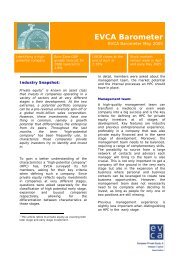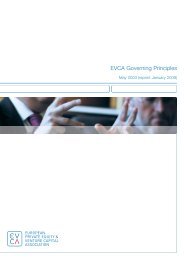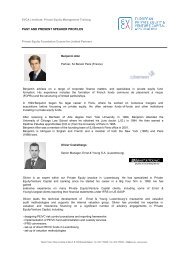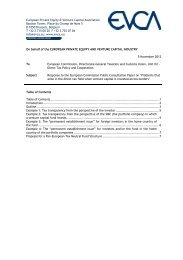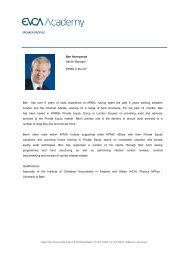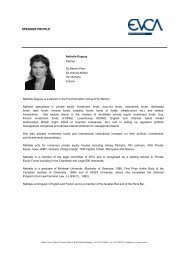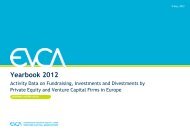Risk Measurement Guidelines - EVCA
Risk Measurement Guidelines - EVCA
Risk Measurement Guidelines - EVCA
Create successful ePaper yourself
Turn your PDF publications into a flip-book with our unique Google optimized e-Paper software.
9.2 Projecting cash flows for fundsKey issues> Estimating ranges for return multiples and lifetimefor a fund> Overcoming the lack of market data and usingqualitative inputs> Use of a model that projects cash flows for a fundover its (remaining) lifetime> Use of a non-probabilistic or probabilistic fund model> Applying a discount rate to sum up the present valuefor the fund• Arthus, P. & Teïletche, J. (2004) Asset allocation and Europeanprivate equity: A first approach using aggregated data. Brussels,<strong>EVCA</strong>.• Bauer, M., Bilo, S. & Zimmermann, H. (2001) Publicly TradedPrivate Equity; An Empirical Investigation. 2nd draft, SwissInstitute of Banking and Finance, Universität St. Gallen, WorkingPaper No. 5/01.• Cheung, L., Howley, C., Kapoor, V., Smith, A. (2003)Standard&Poor’s, 2003; “Going Public with Private Equity CFOs,Structure Finance, Credit Products Criteria Report, Michael Moise,Michael Romer, Michelle Galvez, Richard Hrvatin, Steve Lee,Elizabeth Koo, Fitch, 2002.• Hoek, H. (2007) An ALM Analysis of Private Equity. ORTEC Centrefor Financial Research. January. Available at http://files.ortecfinance.com/Publications/research/OCFR_App_WP_2007_01.pdf,[accessed 2 July 2008]• Kaplan & Peterson (1997)• Kaserer, C. & Diller, C. (2004) European Private Equity - A CashFlow based Performance Analysis. Brussels, <strong>EVCA</strong>.• Kerins, F., Kiholm Smith, J. and Smith, R. (2003) “Opportunity Costof Capital for Venture Capital Investors and Entrepreneurs”working paper, February. http://leeds-faculty.colorado.edu/bhagat/EntrepreneursOpportunityCost.pdf• Kocis, J.M., Bachman, J.C., Long, A.M. & Nickels, C.G. (2009) InsidePrivate Equity – The Professional Investor’s Handbook. John Wiley& Sons. Hoboken. New Jersey.• Ljungqvist, A. & Richardson, M. (2003) The Cash Flow, Return and<strong>Risk</strong> Characteristics of Private Equity. Unpublished working paper,New York University, Finance Working Paper No. 03-001. Availablefrom http://ssrn.com/abstract=369600. [Accessed 12 October 2004].• Meyer, T. & Mathonet, P.-Y. (2005) Beyond the J Curve. John Wiley& Sons. Chichester.• Moskowitz, T. & Vissing-Jørgensen, A. (2002) The Returns toEntrepreneurial Investment: A Private Equity Premium Puzzle?American Economic Review, Vol. 92, No. 4, pp. 745-778.• Takahashi, D. & Alexander, S. (2001) Illiquid Alternative Asset FundModelling of the Yale University Investment Office “InternationalPrivate Equity and Venture Capital Valuation <strong>Guidelines</strong>” (“IPEV<strong>Guidelines</strong>”, see http://www.privateequityvaluation.com/documents/International_PE_VC_Valuation_<strong>Guidelines</strong>_Sep_2009_Update_110130.pdf)• Takahashi, D. and Alexander, A. (2002). Illiquid Alternative Asset FundModeling, Journal of Portfolio Management, Winter 2003, 90-100.• Tolkamp, C. (2007) Predicting Private Equity Performance – TheDevelopment of a Private Equity Performance-Forecasting Modelfor AEGON Asset Management. Master’s Thesis in IndustrialEngineering & Management. University of Twente. The Netherlands.http://essay.utwente.nl/771/1/scriptie_Tolkamp.pdf• van der Heijden, K. (1996) Scenarios – The Art of StrategicConversation. John Wiley & Sons. Chichester.• Weidig, T. & Mathonet, P.-Y. (2004) The <strong>Risk</strong> Profile of PrivateEquity. January. Available at http://ssrn.com/abstract=495482,[accessed 16 June 2008]• Weidig, T. (2002a) Towards a <strong>Risk</strong> Model for Venture CapitalFunds: Liquidity and Performance Forecasting. Available athttp://ssrn.com/abstract=353562, [accessed 30 April 2009]• Weidig, T. (2002b) A <strong>Risk</strong> Model for Venture Capital Funds.Available at http://papers.ssrn.com/sol3/papers.cfm?abstract_id=365881, [accessed 21 September 2011]• Zimmermann, H. et al. (2004) The <strong>Risk</strong> and Return of PubliclyTraded Private Equity. University of Basel, WWZ/Department ofFinance, Working Paper No. 6/04.9.3 Determining a discount rateKey issues> The choice of a discount rate should becomplementary to the risks modelled in the cashflow forecast:- First implication: it is important that differentsources of uncertainly are only reflected once.For instance, the impact of inflation and interestrate risks can be modelled as part of either thecash flow model or the discount rate, but shouldn’tbe modelled by both. Likewise, if the cash flowmodel takes care of the probability of success orfailure of an individual company then the discountrate should not be higher than what could beexpected to account for possible default events.- Second implication: If the cash flow forecast useshistorical data, the discount rate should reflect thesame time frame.<strong>EVCA</strong> <strong>Risk</strong> <strong>Measurement</strong> <strong>Guidelines</strong> 2013 I 33



